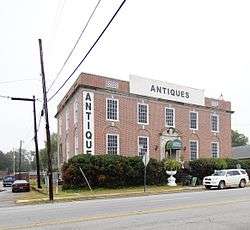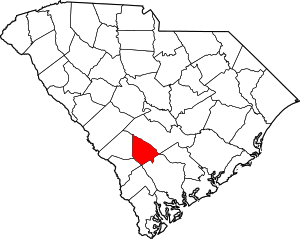Denmark, South Carolina
Denmark is a city in Bamberg County, South Carolina, United States. The population at the 2010 census is 3,538.
Denmark, South Carolina | |
|---|---|
 The American Telephone and Telegraph Company Building | |
| Nickname(s): "City of Pride" "Dirty D" | |
Location of Denmark, South Carolina | |
| Coordinates: 33°19′16″N 81°8′32″W | |
| Country | United States |
| State | South Carolina |
| County | Bamberg |
| Government | |
| • Type | Mayor-Council-Commission |
| • Mayor | Gerald E. Wright |
| Area | |
| • Total | 3.91 sq mi (10.13 km2) |
| • Land | 3.91 sq mi (10.12 km2) |
| • Water | 0.00 sq mi (0.01 km2) |
| Elevation | 240 ft (73 m) |
| Population (2010) | |
| • Total | 3,538 |
| • Estimate (2019)[2] | 2,934 |
| • Density | 751.15/sq mi (290.03/km2) |
| Time zone | UTC−05:00 (Eastern (EST)) |
| • Summer (DST) | UTC−04:00 (EDT) |
| ZIP Code | 29042 |
| Area code(s) | 803, 839 |
| FIPS code | 45-19105[3] |
| GNIS feature ID | 1247519[4] |
Geography
Denmark is located in northwest Bamberg County at 33°19′16″N 81°8′32″W (33.321173, -81.142289).[5] U.S. Route 78 and U.S. Route 321 cross in Denmark just north of the downtown area. US 78 leads east 6 miles (10 km) to Bamberg, the county seat, and west 8 miles (13 km) to Blackville. US 321 leads north 9 miles (14 km) to Norway and south 7 miles (11 km) to Govan.
According to the United States Census Bureau, the city has a total area of 3.8 square miles (9.9 km2), of which 0.004 square miles (0.01 km2), or 0.09%, is water.[6]
Demographics
| Historical population | |||
|---|---|---|---|
| Census | Pop. | %± | |
| 1890 | 366 | — | |
| 1900 | 724 | 97.8% | |
| 1910 | 1,075 | 48.5% | |
| 1920 | 1,254 | 16.7% | |
| 1930 | 1,713 | 36.6% | |
| 1940 | 2,056 | 20.0% | |
| 1950 | 2,814 | 36.9% | |
| 1960 | 3,221 | 14.5% | |
| 1970 | 3,571 | 10.9% | |
| 1980 | 4,434 | 24.2% | |
| 1990 | 3,762 | −15.2% | |
| 2000 | 3,328 | −11.5% | |
| 2010 | 3,538 | 6.3% | |
| Est. 2019 | 2,934 | [2] | −17.1% |
| U.S. Decennial Census | |||
As of the census[3] of 2000, there were 3,328 people, 1,331 households, and 846 families residing in the city. The population density was 1,096.0 people per square mile (422.7/km2). There were 1,537 housing units at an average density of 506.2 per square mile (195.2/km2). The racial makeup of the city was 85.91% African American, 12.74% White, 0.09% Native American, 0.51% Asian, 0.06% from other races, and 0.69% from two or more races. Hispanic or Latino of any race were 0.75% of the population.
There were 1,331 households, out of which 29.8% had children under the age of 18 living with them, 30.2% were married couples living together, 27.5% had a female householder with no husband present, and 36.4% were non-families. 32.0% of all households were made up of individuals, and 11.7% had someone living alone who was 65 years of age or older. The average household size was 2.47 and the average family size was 3.15.
In the city, the population was spread out, with 26.8% under the age of 18, 9.7% from 18 to 24, 24.7% from 25 to 44, 24.1% from 45 to 64, and 14.7% who were 65 years of age or older. The median age was 36 years. For every 100 females, there were 85.6 males. For every 100 females age 18 and over, there were 82.6 males.
The median income for a household in the city was $17,578, and the median income for a family was $22,346. Males had a median income of $22,110 versus $13,767 for females. The per capita income for the city was $11,243. About 33.4% of families and 35.2% of the population were below the poverty line, including 51.9% of those under age 18 and 30.8% of those age 65 or over.
History
Cleveland Sellers oral history interview conducted by John Dittmer in Denmark, South Carolina, 2013 March 21.
Cleveland Sellers shares memories of growing up in Denmark, South Carolina, especially the influence of Voorhees College in the community. He organized a Youth Chapter of the National Association for the Advancement of Colored People (NAACP) in Denmark, and he describes the group's activities. He discusses his first impressions of Howard University, where he joined the Nonviolent Action Group (NAG). He shares memories of the March on Washington and the role of students in organizing it, his involvement in the Student Nonviolent Coordinating Committee (SNCC), and his role in the Mississippi Freedom Project. He also describes the goals of the Mississippi Freedom Democratic Party and the tensions that developed within SNCC in the late 1960s.
Sellers, Cleveland, 1944- interviewee.
Dittmer, John, 1939- interviewer.
Civil Rights History Project (U.S.)
https://www.loc.gov/item/2015669180/
Denmark was originally called Grahams Turnout, as it was founded in the 1830s for a railroad extension and turnout.[7] It was later renamed after B. A. Denmark, a railroad official.[8]
In April 1893, Mamie Baxter, a fourteen-year-old girl in Denmark, alleged that an African American unknown to her had attempted to attack her. John Peterson, a suspect, appealed to South Carolina Governor Benjamin Tillman for protection, fearing he would be lynched if taken to Denmark, and saying he could prove his innocence. He was taken by the mob, put on "trial" and, after the mob found him guilty, was murdered by hanging.[9]
Shown Peterson before the crowd killed him, Baxter reportedly testified:
"I don't know him sir, that don't look like him at all. He is the same color, that's all. He don't talk like the man; he is thinner in the face, he was as dark as this man, but his eyes don't look like him."[10]
Historic sites
The American Telephone and Telegraph Company Building, Denmark High School, and the Voorhees College Historic District, part of the campus of the historically black college, are listed on the National Register of Historic Places.[11]
Transport
Amtrak, the national passenger rail system, serves Denmark, operating its Silver Star daily in each direction, between Miami, Florida by way of Tampa, Jacksonville, and Savannah, and New York, New York by way of Columbia, Richmond, Washington, and Philadelphia.
Parks
- Ceceile Playground and Court
- Simons Davis Park
- The Art Park
Education
Denmark contains two colleges: Denmark Technical College and Voorhees College.
Denmark has a public library, a branch of the ABBE Regional Library System.[12]
Arts and culture
Denmark is home to the Dog Wood Festival, which is a festival that includes rides, games, and food/drink stands and was originally hosted 517.01 ft (15758.4648 cm [estimated]) from Beech Ave to South Beech Ave, but was moved to Cypress St as of 2019. According to the history of the Dog Wood, it first began in the year of 1985 and still goes on once a year. This usually happens in April on a sunny day. This festival benefits the community.
Each year of the festival visitors region-wide come to Denmark, usually stopping by one of Denmark's retailers and restaurants before or after going to the festival. This has a good effect on the local economy. A restaurant like McDonald's usually has an average of 14 cars located on the property, but on a festival day, locals say that the car population gets boosted by more than half.
Notable people
- Elizabeth Evelyn Wright, founder of Voorhees College
- Cleveland Sellers
- Bakari Sellers
- Ted Potter Jr.- PGA Tour Golfer- Resided as a child in Denmark - Parents former owners of Crestwood Country Club
- Priya Gill- Former Indian actress
References
- "2019 U.S. Gazetteer Files". United States Census Bureau. Retrieved July 29, 2020.
- "Population and Housing Unit Estimates". United States Census Bureau. May 24, 2020. Retrieved May 27, 2020.
- "U.S. Census website". United States Census Bureau. Retrieved 2008-01-31.
- "US Board on Geographic Names". United States Geological Survey. 2007-10-25. Retrieved 2008-01-31.
- "US Gazetteer files: 2010, 2000, and 1990". United States Census Bureau. 2011-02-12. Retrieved 2011-04-23.
- "Geographic Identifiers: 2010 Demographic Profile Data (G001): Denmark city, South Carolina". U.S. Census Bureau, American Factfinder. Archived from the original on February 12, 2020. Retrieved April 2, 2014.
- Boman, Roberta A. (Aug 20, 1981). "Railroad gave towns names". The Sumter Daily Item. pp. 6B. Retrieved 28 October 2015.
- Gannett, Henry (1905). The Origin of Certain Place Names in the United States. Govt. Print. Off. pp. 104.
- Kantrowitz, Stephen David (2000). Ben Tillman & The Reconstruction of White Supremacy. Chapel Hill: University of North Carolina Press. ISBN 0807825301. OCLC 41528409.
- "The Abbeville Press and Banner. (Abbeville, S.C.) 1869-1924, April 26, 1893, Image 4". 1893-04-26. ISSN 2372-6768. Retrieved 2017-09-20.
- "National Register Information System". National Register of Historic Places. National Park Service. July 9, 2010.
- "South Carolina libraries and archives". SCIWAY. Retrieved 7 June 2019.
